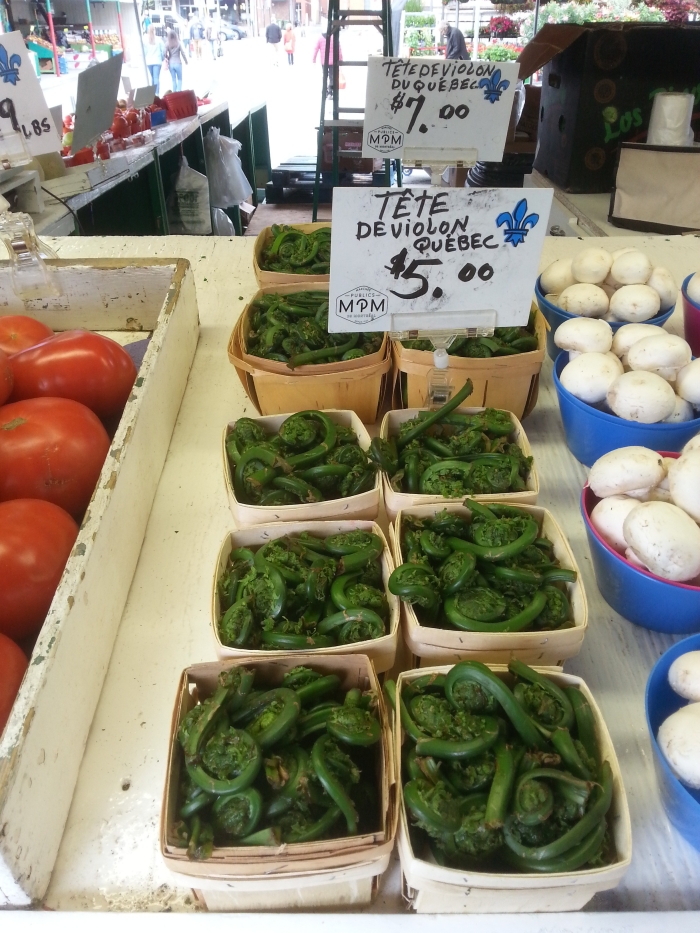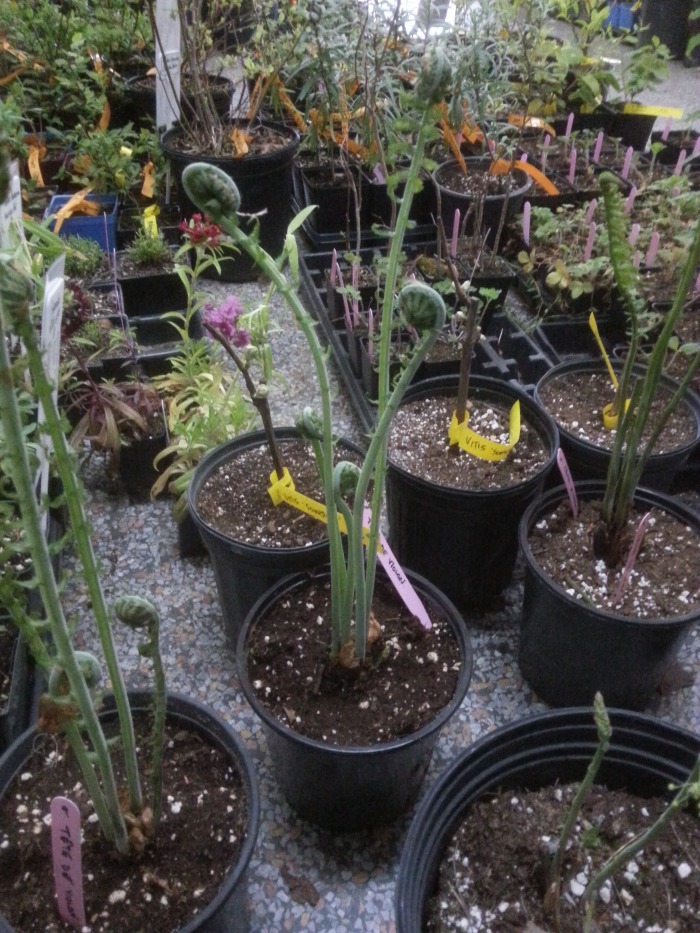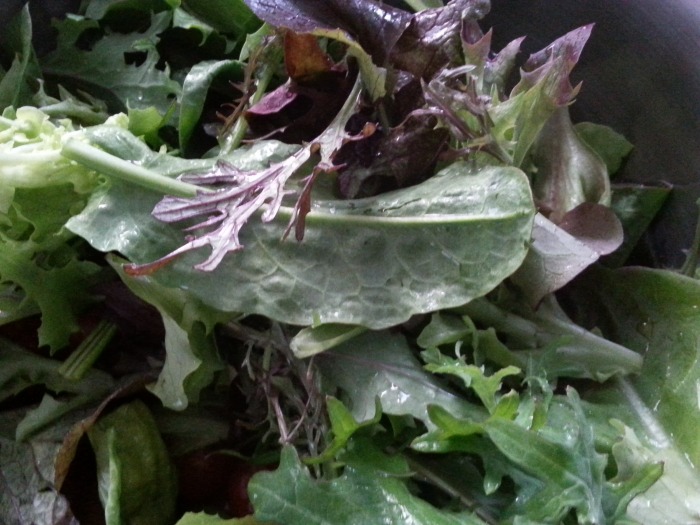The trees are coming into leaf
Like something almost being said;
[…]
Last year is dead, they seem to say,
Begin afresh, afresh, afresh.
Philip Larkin, The Trees
Come May, they are back out again.
Shrugging off its winter blues, the market lets out a huge yawn and its doors open; after the long winter months, it comes as a liberation: the stalls are set up outdoors once more, and the surface of the market multiplies. This special moment feels like playtime at school; at the end of a boring, lengthy lesson, the bell would finally ring. The schoolchildren would break free and let loose, running to the playground where they would frolic until the lessons resumed.
Because this is spring in Québec: frantic impermanence, an exponential season, a transition state. Time picks up speeds, it gains momentum and gathers pace: it seems exceptionally fast, unpredictably short. What is in blossom today, tomorrow may already be in full leaf. It is a burst of energy, opposite to the sluggishness of sultry summer sunsets and yawning winter dawns.

There is no better place to observe these frantic changes than at Jean-Talon farmers’ market, the place where “Montrealers pretend to be in Naples or Marseille” according to the writer David Homel (as cited in Carnets de Montréal) – after all, the market is aptly located in the Little Italy district. Spring at Jean-Talon market is a time of renewal and unending surprises: fresh seasonal produce starts to be available, and new vegetables show up week after week.
And that’s where it all began.
Fiddling with danger
The lady behind the stall looked as if she was about to let me into some secret of sorts that only the chosen could ever know. She blinked at me as she was talking, then she pointed at the little box in front of her, full of what seemed to be unfurled green coils, and, finally, she stared back at me, waiting for my reaction. Surprised by my questioning gaze, she curled her mouth into a mischievous, somewhat beguiling smile that she flashed at me with yet another blink of her eyes.
“You’ll adore them, I bet” she said. “Just boil them twice, to be on the safe side”.
The final remark startled and confused me even further. I felt as if the lady had cast a spell on me and I was only slowly coming around. Yes, she had extolled the virtues of that strange-looking unknown vegetable, but I wasn’t so sure I wanted to try this unmatched, very Québécois spring delicacy, even if this would mean failing my test of Québec-ness.
If in doubt, back out.
I smiled at the lady and I walked down the aisle and, all of a sudden, I started spotting them everywhere, on all market stalls. Fiddleheads, or têtes de violon.

A handout attracted my attention like a red flashing warning light…

What was so terribly wrong with eating these delicate greens, reminding me of a motif from an Arts and Crafts decorative pattern? Why on Earth do you need to boil them twice, and pay such attention to how you handle them?
No sooner had I got home than I ran to the kitchen, where I carefully slid a thick volume out of a massive pile, dangerously leaning sideways, of cookery books.

Holding my breath, I then started flipping frantically through my copy of On Food and Cooking, the ultimate reference book on all things edible by Harold McGee, until I found the answer to my question on page 259 – watch out, those featuring on the market stalls are ‘ostrich ferns’, aka Matteuccia species:
Bracken-fern toxins cause several blood disorders and cancer in animals that graze on this common fern (Pteridium), which is sometimes collected in the young “fiddlehead” stage for human consumption. Ostrich ferns, Matteuccia species, are thought to be a safer source of fiddleheads, but there’s little solid information about the safety of eating ferns. It’s prudent to eat fiddleheads in moderation, and to avoid bracken ferns by checking labels and asking produce sellers.
The story unfurls…
So, any suspicion that fiddleheads can pose harm has seemingly been allayed, at least until further evidence emerges. Looking up on the Internet, I found this page from Canada’s health agency and an article in Chronica Horticulturae featuring an interesting historical overview on fiddleheads, from which I cite this excerpt:
The curled fiddlehead fronds that emerge in late April or May in the northern hemisphere herald the end of winter and in many areas are the first fresh spring vegetable. Growing in the moist soilbeds adjacent to rivers and streams, picking fiddleheads is a rite of Spring for many Maritime Canadians and New Englanders, which dates back to the very first days of European colonization. Previous to this, native peoples savoured the fiddlehead since time immemorial […] In North America, many eastern native peoples have historically consumed the ostrich fern. The Malecite Indians of the St. John river valley used fiddlehead greens as a Spring tonic […], while the Abenaki of New England roasted the entire crown over a bed of hot stones, covering it with branches […]. The Passamoquoddy and Penobscot Indians of Maine also harvested, consumed and sold ostrich fern greens.
Fiddleheads would become part of the European settlers’ diet in New Brunswick as early as in the 1700s, as you can read in another article. Imagine these people, weary and hungry after weathering one of those harsh Québec winters that drag on well into April. Newcomers to unchartered territories, they would anxiously wait for the snow to melt; when the thaw eventually arrived, their surprise and joy must have been great. In a few days’ time, the white blanket would vanish under the ever warmer sun, unveiling the yellowish grass scorched by the frost, grass that would soon thrive green again. A spectacular metamorphosis that repeats itself in Montréal every year, more or less at the turn of April. A couple of weeks later, the settlers, desperately hungry and trying to eke out a living on dwindling supplies, would venture on the muddy banks of the streams flooded by the thawing ice, maybe trailing, furtively, someone who had always known where to look for fiddleheads. Or, more simply, a member of one of the First Nations may have disclosed the location of patches of ostrich ferns by using that universal language made of gestures and nods, while sharing some of these strange-looking greens; what was the settler’s first reaction at the fiddlehead’s “delicate, unique taste, which has been likened to the quality of asparagus and artichoke,with some of broccoli’s brute strength”? We can only guess. These graceful ferns were apparently instrumental in the survival of those American Loyalists (aka: those who stuck with the British Empire during the American War of Independence) who left the US to resettle in New Brunswick in 1783. Ill-equipped for the winter, they resorted to foraging for food in the wild in the following spring and ate fiddleheads along with “grapes and even the leaves of trees” as a source reports.

The Chronica Horticolturae article does include a section on fiddlehead toxicity (page 14), pointing out from the outset that, although “Matteuccia struthiopteris is thought to be safe in the human diet”, there are periodical outbreaks of gastrointestinal illness associated with the consumption of these ferns, including an occurrence in Quebec in 1999. One of the references is a paper on several cases of food poisoning related to the consumption of fiddleheads of the ostrich fern, and all occurring in New York and western Canada in May 19941. This report describes the symptoms affecting those who had eaten fiddleheads at a restaurant in the state of New York: nausea, vomiting and diarrhoea. As in a detective story, the authors hunt for clues as to the cause of the illness. The fiddleheads had been grown on a farm located (relatively) far from sewage treatment plants and industries. So, the hypothesis of a chemical or bacteriological contamination lost ground. Samples were taken to laboratories, and analysed with state-of-the art methods – just imagine a vintage episode of CSI: Crime Scene Investigation set in the 1990s, with bulky white computers running MS-DOS instead of slim tablets and fancy touchscreens. The plot could for instance revolve around an outbreak of food poisoning affecting the favourites for the 1994 Football World Cup, which took place in the US: will this unexpected twist influence the final outcome of the competition? (Relive the actual, dramatic final match here).
From fiction back to the lab, and hard facts: no evidence of pathogens like Staphylococcus aureus and Bacillus cereus, pesticides such as organophosphates, or heavy metal accumulation was found. The mystery deepened: the detectives had to look elsewhere. It was by comparing different recipes using ferns sourced from the same farm that the sleuths picked up another trail: in fact, nobody had fallen ill at a second restaurant, where the fiddleheads had been boiled for ten minutes and then sautéed. Instead, the fiddleheads served to the unfortunate patrons had been “removed from a refrigerator and sautéed for 2 minutes in butter, garlic, salt, and pepper” 1. Further research unveiled other cases of food poisoning, this time in Canada, and completely unrelated to the first; yet, a cross-check of the available evidence strongly suggested that1
the most likely cause of illness in each of these outbreaks was an unidentified toxin. Heating and boiling may either inactivate or leach the toxin from the plant.
The fiddlehead toxin continues to defy chemists and other researcher to this day: when I conducted a survey of the recent literature on this subject, I did not found any new report on the identification of the mystery chemical. By the way, I came across a few publications unveiling the supposedly whopping health benefits of fiddleheads, and here is a quote from one of them:
For green vegetable tissue, it also has a high and unusual fatty acid content, which includes the omega-3 eicosapentaenoic acid, and the omega-6 arachidonic, γ-linoleic and dihomo-γ-linolenic acids. Thus, the ostrich fern fiddlehead can be recommended as a healthful vegetable in the human diet and should be consumed where it is seasonally available.
Lots of chemistry in there, but let’s stop fiddling with fiddleheads for now. In fact, other chemically interesting encounters were in store among the market stalls.
Salad days
On the following Saturday, when we went back for our weekly shopping, you could hardly recognise the market: flowers everywhere, in a dazzling overflow of colours, people moving like buzzing bees among the pots and the petals, taking pictures, smelling, like busy pollinators. We were overwhelmed by this larger-than-life sensorial feast.
The organic farm had set up their stall, too. The queue testified to their success, as the number of their aficionados keeps growing among Montréal’s (deep-pocketed) lovers of wholesome food. Eating the mesclun, the mixed salad grown on this farm, is one of ours guilty healthy pleasures. This time, though, something else would spice up our lunch in a completely unexpected way.
I tucked in with ravenous appetite. The crunchy leaves cracked open and filled my tongue with their juices, sending my taste buds off the scale. It seemed as if my whole mouth had been flooded with concentrated lemon juice, but the taste was somewhat sharper, nothing I had experienced before. I started chuckling in a silly way, and, while still squeezing my eyes in discomfort, I picked up another of those large, oval leaves that stood out in the midst of a sea of non-descript green. Eat, weep, repeat : the surprise was giving way to a sort of appreciation of a newly-acquired taste. Sorrel had definitely won me over.

When lunch was over, I reached for McGee’s sacred text once more. The hefty tome in my hands, I stood up and started reading aloud (page 411):
Sorrel is the startlingly sour leaf of several European relatives of rhubarb and buckwheat that are rich in oxalic acid : Rumex acetosa, scutatus and acetosella. Cooks use them mainly as a source of acidity, and they also provide a more generic green aroma. Sorrel readily disintegrates with a little cooking into a sauce-like puree […] whose chlorophyll turns drab olive from the acidity.

Oxalic acid, here’s the culprit. An image suddenly flashed through my mind, and I pictured myself sprinkling my salad with a dash of that chemical, so useful in the lab, but in the kitchen so feared, and by so many. In fact, oxalic acid features in the list of plant-related chemicals McGee tells us we should be wary of, alongside, of course, fiddlehead toxins. The problem with oxalic acid is well known : it contributes to the formation of kidney stones. Here is a TED talk if you wish to learn more about it :
Pure oxygenius
There is a very ancient chemical connection between the name oxalic acid and the French term for sorrel, oseille. The plant inspired the acid, and their common…root is the Greek oxalis (=generic sorrel), relayed by Latin. The name oxalis itself has a pungent taste on the tongue, embedded in the word oxus, (ὀξύς), “sharp”. It is reminiscent of an even ancient term that would later morph into the word acid. This linguistic detour comes full circle when we think about the etymology of oxygen (“acidifying principle”), and when we remember the chemist who first isolated oxalic acid, and who was among the first to discover oxygen: Carl Wilhelm Scheele (1742-1786).
The brevity of this (already too long) blog post would not do justice to this major, yet somewhat underrated, figure in chemical history. The Swedish chemist’s biography can be read in this paper by the Royal Swedish Academy of Engineering Sciences, and the story of the controversy over the discovery of oxygen sparked the inspiration for the play with the same title, written by chemists Carl Djerassi and Roald Hoffmann (the synopsis and the text of the play are available on Hoffmann’s website). This is a tale on competition, ambition, the rush to be the first to publish and more, much more. Djerassi and Hoffmann identify the discovery of oxygen as the turning point when chemistry becomes a fully-fledged, “modern” science. If you want to get a flavour of the electric atmosphere of chemistry research in the second half of the 18th century, read this excerpt from Histoire de la chimie by Bernadette Bensaude-Vincent and Isabelle Stengers (my translation from French). The year is 1766; Cavendish has just isolated hydrogen, and now
the hunt for the various “airs” has begun[…]. It takes place throughout Europe, from Uppsala to Paris, from London to Berlin, at a time when European chemists are constructing a veritable network: exchange of letters, travels, scientific journals; Krell’s Chemische Annalen call for papers is not only addressed to German chemists, but also to scientists from all over Europe. Chemists from all walks of life get involved: Cavendish and Boyle are rich members of the aristocracy; Lavoisier (1743-1794) is an academic and a civil servant who dips into his own pockets to equip his laboratory; Priestley (1733-1804) is a Unitarian minister whose laboratory was funded by an aristocratic patron; Scheele (1742-1786) is an apothecary who learnt chemistry on his own: he will work in the shadows and with limited means without any formal academic affiliation, wandering throughout Sweden from Stockholm to Uppsala, and from here to Köping [a town in central Sweden], where he will finally purchase his own pharmacy.
Scheele, described as “an exceptionally modest fellow who never sought academic recognition and only ever attended one meeting of the Swedish Royal Academy of Sciences“2, was in other words a real outsider in the cut-throat world of chemistry research, so aptly summarised by Djerassi’s words in his 2014 interview to Chemistryworld:
We are a discipline which is probably the most collegial of them all. At the same time, the most brutally competitive, and that combination is very important one. The other one is ambition. No question. We want to be first. We have an Olympic game, you might say, in which there’s only a gold medal, there are really no silvers or bronzes.
This is a central theme of Djerassi’s and Hoffmann’s play, as we learn from the synopsis:
The ethical issues around priority and discovery at the heart of this play are as timely today as they were in 1777. As are the ironies of revolutions: Lavoisier, the chemical revolutionary, is a political conservative, who loses his life in the Jacobin terror. Priestley, the political radical who is hounded out of England for his support of the French revolution, is a chemical conservative. And Scheele just wants to run his pharmacy in Köping, and do chemical experiments in his spare time. For a long time, he—the first man on earth to make oxygen in the laboratory—got least credit for it. Will that situation be repaired 230 years after his discovery?
Scheele started out as a teenage pharmacy apprentice in Sweden’s bustling port of Göteborg and, thanks to his dazzling experimental skills and sheer chemical genius, he would become a leading figure on the contemporary chemical stage, and this apparently without keeping a lab journal3 (don’t follow his example!). Even after rising to fame, Scheele kept on working at his own pharmacy in Köping instead of enjoying the academic spotlight as a professor3. Overshadowed by the tussle over oxygen, Scheele’s isolation of oxalic acid from wood sorrel (not the common sorrel found in my salad) in 1768 is anyway a milestone, laying the foundations for Wöhler’s synthesis of this compound in 1824. Working in his laboratory in the city of Malmö, Scheele showed that4
through boiling and crystallisation, it was possible to produce sorrel salt (sal acetosellae [potassium oxalate]) which although poisonous in large doses, was popular due to its pleasant sour and refreshing taste.
In old age, Scheele’s health started to deteriorate due to kidney problems, a sad coincidence for the man who had been able to isolate oxalate, the responsible of kidney stones.
Apart from this, oxalic acid comes in very handy when one needs to clean metals, not only rusted iron, but also something a bit fancier, like titanium. If you want to get rid of the thin oxide layer that covers (“passivates”) titanium metal, there’s nothing better than a good hot oxalic acid bath (concentration: ca. 10% in weight) that will etch and clean the metal. After leaving some titanium foils in oxalic acid at 80°C for half an hour, you should see something like this (rinse well before use):
Back to Marché Jean-Talon for our closing remarks. More and more vegetables will come to the market as summer follows spring and the season unfolds. Rhubarb and asparagus are now in the spotlight on the stalls, both of them with their own chemically distinctive character: the stalk of former contains a relative large amount of oxalic acid, while the latter imparts some people’s urine with a pungent smell – admittedly because of the metabolites of the sulphur-containing asparagusic acid.
One thing is certain: there is a boon and a bane in everything, and vegetables make no exception. Rather, what matters is to keep our eyes open and, why not, add a pinch of chemistry in our salad.
All with a grain of salt.

Footnotes
1. MMWR. 1994. Ostrich fern poisoning – New York and Western Canada, 1994. Morbid. Mortal. Week. Rprt. 43:683-684.
2. Hugh Aldersey-Williams, Periodic Tales, Penguin Books, 2012, page 151
3. Reported in J.L. Marshall and V.R. Marshall, Rediscovery of the Elements, The Hexagon of Alpha Chi Sigma, Spring 2005
4. The quote is from the paper by the Royal Swedish Academy of Engineering Sciences








